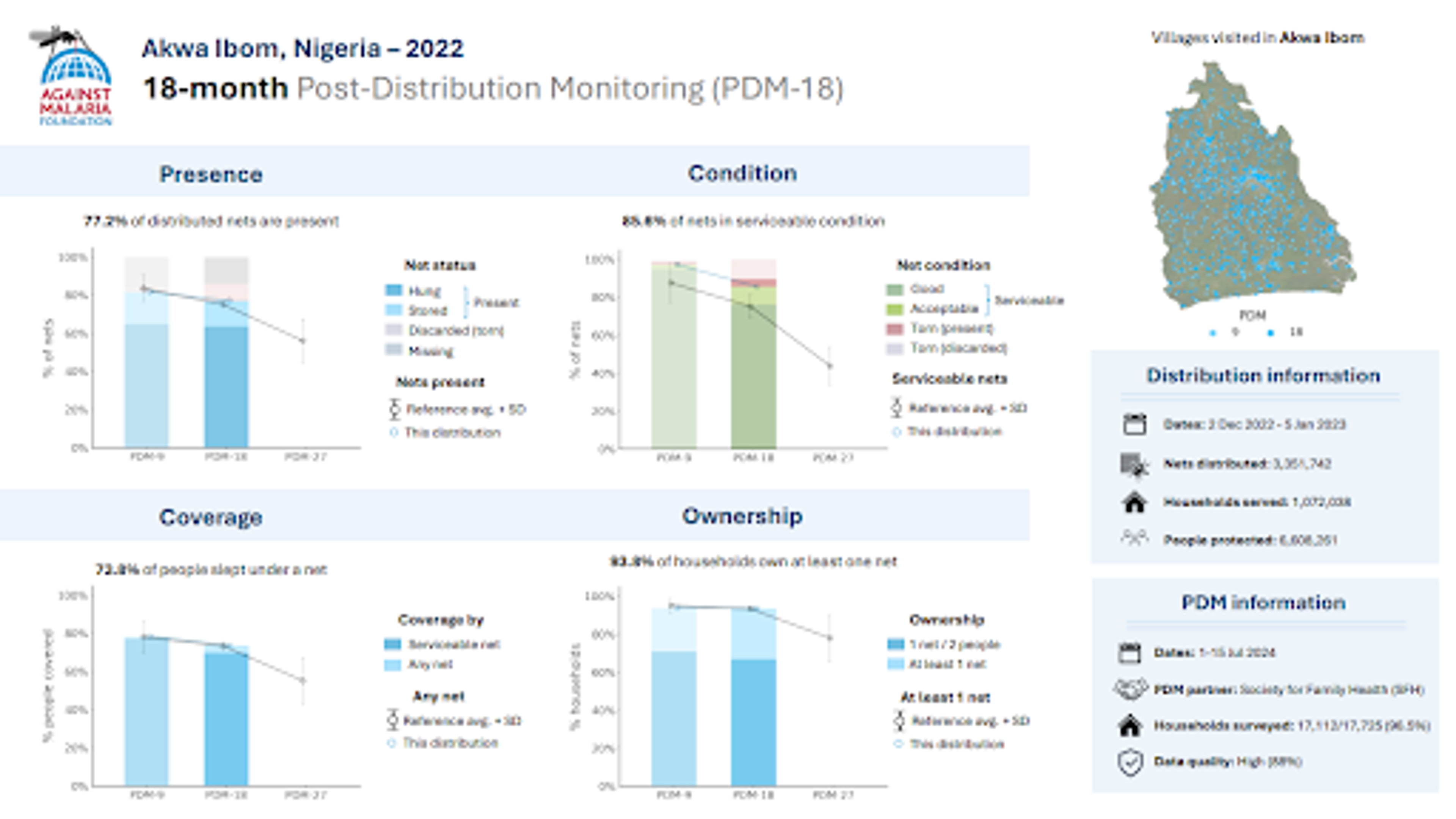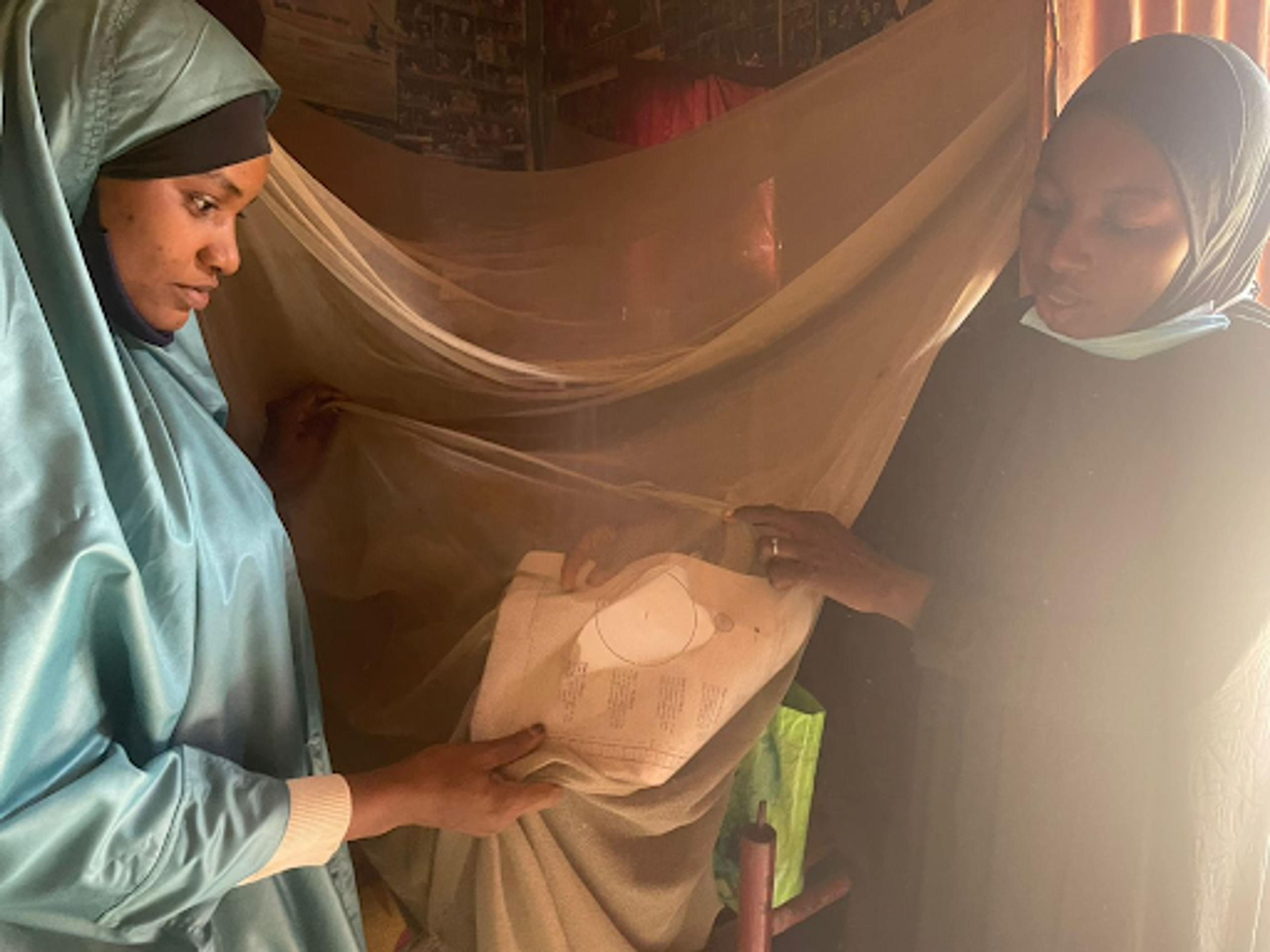A spotlight on Against Malaria Foundation's Post-Distribution Survey (PDM) process
This guest post from AMF explains why and how their team conducts post-distribution surveys to monitor impact.
Against Malaria Foundation's work is surprisingly simple. They distribute bed nets to households in need, reducing the death toll from a huge killer of children under 5: malaria.
The results? Tremendous. With a $5 net, a fatal bite can be prevented. A child can live. Households who can't access medical care because of location or situation have free ammunition against one of their biggest public health threats.
Against Malaria Foundation (AMF) has long been one of our recommended charities — so we thought our readers might be interested in hearing about a lesser-known aspect of their work: post-distribution surveys.
What's a post-distribution survey? It's when AMF — through partnerships with local organisations — visits a selection of the households that received nets and follows up on net condition and usage, allowing the AMF team to adapt, iterate, and monitor their programs for maximum impact.
We asked AMF to share some details about this important part of its work. Here's what they said.
From Planning to Field Work: How the Monitoring Process Works
Background
Malaria remains one of the world's most persistent public health challenges, with an estimated 250 million cases occurring annually. Despite being preventable and treatable, this mosquito-borne disease continues to claim an estimated 600,000 lives each year, primarily among children under five and pregnant women in sub-Saharan Africa.
The Against Malaria Foundation (AMF) works to reduce this burden by distributing long-lasting insecticide-treated nets (LLINs) in universal coverage campaigns. This is possible thanks to donations from generous people around the world. 100% of donations go to buy nets. For example, a $10 donation funds approximately five nets that will protect 10 people when they sleep at night.
Through partnerships with implementing organizations and national health ministries, AMF has distributed over 190 million nets to protect more than 350 million people from malaria. Each net distribution is carefully planned with accountability measures in place to ensure that nets go where intended. An example of this is digital data collection at household level during distribution. The information collected on smartphones or tablets accurately documents how many nets each family needs and receives. This enables universal coverage - typically one net for every two people - ensuring that entire regions can sleep protected from the bites of malaria-carrying mosquitoes.
AMF recognizes that distribution is just the beginning of effective malaria prevention. To verify that nets reached the households and continue protecting people over their expected 3-year lifespan, AMF partners with local organizations to conduct Post-Distribution Monitoring (PDM) surveys. These PDM surveys take place at regular intervals - typically at 9, 18, and 27 months after distribution. They track four key indicators: net presence (whether distributed nets remain in households), coverage (how many people sleep under nets), usage (whether people use the nets correctly), and condition (whether nets remain effective). AMF has conducted 150 PDM surveys across nine countries, collecting data from 2.4 million households across diverse and often challenging environments.

Above: Publicly shared 1-page report presenting results of PDM conducted in Akwa Ibom state, Nigeria.
The monitoring process
For each monitoring round, AMF randomly selects villages and households across the entire area that has received nets, ensuring that no regions are excluded. This pre-selection process creates a fully random, unbiased sample — critical for reliable results. Even the most remote or difficult-to-reach households are included, preventing the monitoring from focusing only on convenient locations that might not represent an overall situation.

Above: Rebuild Hope for Africa data collector navigates a muddy rural road during post-distribution monitoring in Bas Uele, DRC
After arriving at a village, data collectors locate the selected households and obtain permission from the residents to conduct the interview. Once permission is granted, the interview can begin. One of the first steps involves capturing household GPS coordinates. While the household location is never publicly shared, the GPS coordinates provide an important layer of data quality verification. By comparing the data collector's current location with the coordinates recorded during distribution, supervisors can confirm that the correct households are being visited. This geographic validation is particularly valuable in areas without formal systems of household addresses.
During the interview, the electronic form guides the data collector through a standardised flow of questions. At each household, information is collected about the household composition and the sleeping arrangements and each present net is physically assessed. The questionnaire’s skip-logic functions streamline the interview by tailoring questions based on previous answers. For example, if a respondent indicates they have nets that are present but not hung, the form presents follow-up questions about reasons for non-use. This adaptive questioning reduces the complexity of the interview by ensuring only relevant questions are displayed, making the process more efficient and less confusing for both data collectors and respondents. By streamlining the interview experience in this way, the platform encourages more accurate and complete responses, improving the quality of the collected data.
.png?w=3840&q=75&fit=clip&auto=format)
Above: Net Assessment - Uganda PDM9 (implemented by Team Initiatives Limited)

Above: Net Assessment - Nigeria, Zamfara state PDM9 (implemented by eHealth Africa)
Throughout the process, there are multiple mechanisms that help to ensure there are no mistakes in the collected data. As an example, the questionnaire’s validation features ensure consistency and completeness of the responses. With partners, AMF has built into the system automatic checks to confirm responses make logical sense — for instance, checking that when a household reports receiving five nets during distribution but only has three now, they provide reasons for what happened to the missing two. If inconsistencies are detected, the data collector is alerted before progressing to the next question. Another mechanism is the 5% verification process, where a different set of data collectors go back to a random selection of 5% of the previously interviewed households, with no knowledge of the data previously collected. As both sets of data collectors ask the same questions, the answers can be compared. When the same key information is recorded in both visits, this indicates a reliable data collection. These systems give us confidence that the results of the PDM are accurate and so can feed into decisions and actions. At the end of the survey, all data is shared with national malaria programmes.
This monitoring system allows AMF to verify the impact of their distributions. The household-level data collected across thousands of communities provides a realistic picture of distribution effectiveness and shows how nets are being used in real-world settings. The evidence gathered through this process serves multiple purposes. It allows AMF to report with confidence to donors on the nets they have funded. This accountability and transparency builds high levels of confidence in AMF’s work. Additionally, by sharing the results with in-country partners, AMF can help to inform actions and policy adjustments based on this data.
Below, we interview founder Rob Mather on the powerful, personal story behind AMF, the organisation responsible for protecting 400 million people from malaria (roughly equal in size to 40% of the entire population of sub-Saharan Africa!) and saving tens of thousands of lives.
It started with one man's fundraiser for a little girl who had suffered 90% burns in a house fire at her home in Suffolk, England, and turned into one of the most efficient and effective charities in the world.